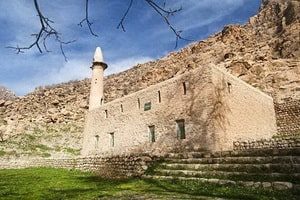
Geographic context
The Kermanshah region is located in the western territories of Iran and most of its surface is occupied by the Zagros mountain range. The capital of the region is the city of Kermanshah and the other main urban centers are: Eslam Abad-e Gharb, Pave, Sar Pol-e Zahab, Qasr-e Shirin, Kangavar and Gilan-e Gharb.
Climate
The climate of the Kermanshah region is influenced by the air currents coming from the Mediterranean Sea and the mountainous areas present within the region itself and, overall, is divided into two climatic zones: one warm in the western territories and the other cold in the rest of the region.
History and culture
Based on evidence and archaeological discoveries, the Kermanshah region is a center where traces of early human settlements and major companies are found in the central Zagros area. All periods of human life, from the Paleolithic and prehistoric era up to the establishment of the great state entities of antiquity, have succeeded one another in this area and have left the mark of their evolutionary path. Archaeological finds show that primitive men, about 9000 years ago, after having abandoned the caves and beginning to tend towards a sedentary life, had chosen this area as the site of their first settlements and, gradually, became permanent. Therefore, it can be said that the most archaic villages of the Middle East in the Neolithic era, from 9800 BC to 7400, took shape in this region.
After the arrival of some Aryan peoples in the 4th and 3rd millennium BC, the slopes of the Zagros Mountains - in those territories that coincide with a part of today's Kermanshah region - were transformed into important mercantile centers. The local merchants traded with those of Susa and Mesopotamia, exchanging the goods. This historical transmigration, in the following periods, became famous as the exodus of the 'Gutei' and 'Cassiti'.
The tribes that lived in the different areas of the Zagros Mountains are mentioned in the inscriptions of Sargon king of Akkad who, from 2048 to. C. up to 2030, ruled the lower Mesopotamia. The names of the populations who lived in these areas were: 'Lullubiti', 'Gutei', 'Monabi', 'Nairi', 'Amada', and 'Parsua'. The 'Lullubiti' were the ancestors of today's Loranic Loris who, in the past, occupied the areas of Sar Pol-e Zahab and Soleymaniye in the Iraqi Kordestan, a country that was considered part of the territories of ancient Persia.
It was in the Sasanian period that the Kermanshah region, more than any other era, was invested with a particular authority and prosperity. Since this region was considered by the Sassanids as their second capital.
In ancient texts in the Pahlavi or Mediopersian language, the name 'Kermanshah' is referred to as 'Kardan Shah'. Such names were used to designate this region from the Sassanid king Bahram IV who ruled for 11 years. The ancient Iranian books attribute the foundation of the Kermanshah city to Tahmuras, the mythical victorious king of demons. However, in the Kermanshah region, on the site of the hill of Ganj Darre, the oldest evidence of how to tame the goats was ascertained, the results of this study were published in the authoritative journal of Science '.
Local cuisine
In the city, rural areas and among the nomadic peoples of the Kermanshah region are prepared different types of local dishes, among which we can mention the following: different types of soup (Ash-e Abbasali, Ashvasati and yogurt soup), Kofte Berenj, Kham Ku (Taple), Shami Kabab, Shir Dagh, Shir Berenj, Zard Alurun, Tamatav, Shi Riye Zh, Kashkak, Changal, Khuresh-and Khalal Badam, Halim-e Gusht, Qorme, Dugh-e Mahalli, Nan-e Sahen , Khurak-e Goje Farangi, Khurak-e Del, Jegar and dozens of other dishes.









